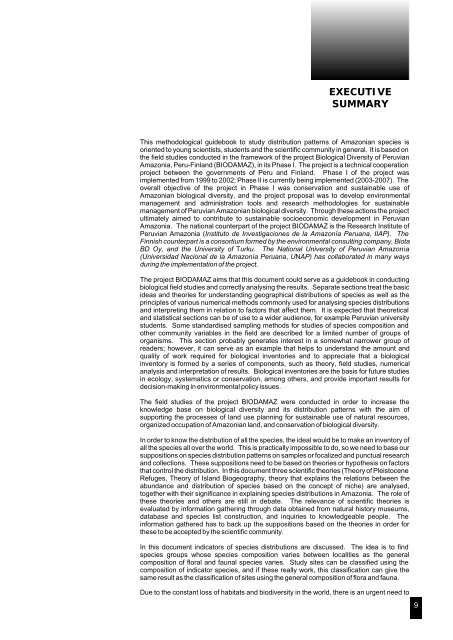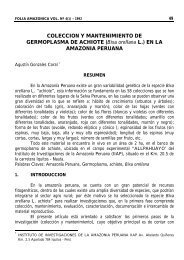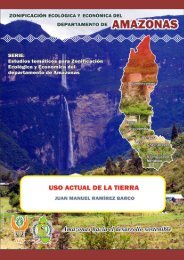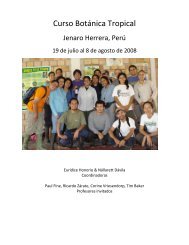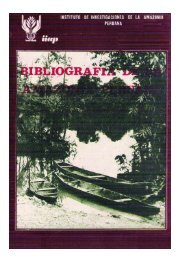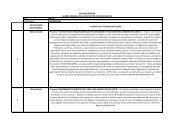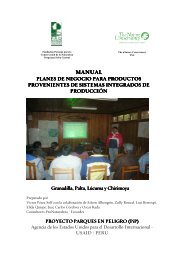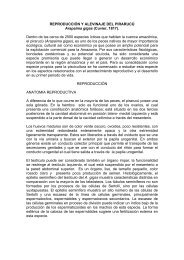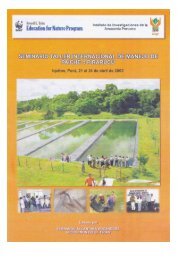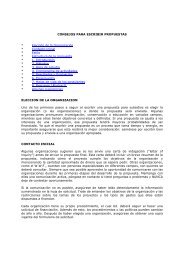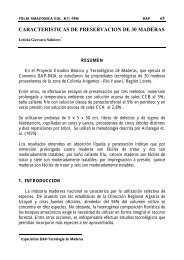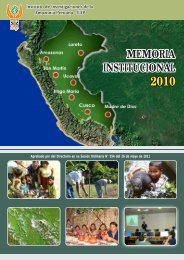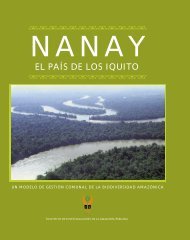Guia para estudiar Patrones de Distribución de Especies
Guia para estudiar Patrones de Distribución de Especies
Guia para estudiar Patrones de Distribución de Especies
You also want an ePaper? Increase the reach of your titles
YUMPU automatically turns print PDFs into web optimized ePapers that Google loves.
EXECUTIVE<br />
SUMMARY<br />
This methodological gui<strong>de</strong>book to study distribution patterns of Amazonian species is<br />
oriented to young scientists, stu<strong>de</strong>nts and the scientific community in general. It is based on<br />
the field studies conducted in the framework of the project Biological Diversity of Peruvian<br />
Amazonia, Peru-Finland (BIODAMAZ), in its Phase I. The project is a technical cooperation<br />
project between the governments of Peru and Finland. Phase I of the project was<br />
implemented from 1999 to 2002; Phase II is currently being implemented (2003-2007). The<br />
overall objective of the project in Phase I was conservation and sustainable use of<br />
Amazonian biological diversity, and the project proposal was to <strong>de</strong>velop environmental<br />
management and administration tools and research methodologies for sustainable<br />
management of Peruvian Amazonian biological diversity. Through these actions the project<br />
ultimately aimed to contribute to sustainable socioeconomic <strong>de</strong>velopment in Peruvian<br />
Amazonia. The national counterpart of the project BIODAMAZ is the Research Institute of<br />
Peruvian Amazonia (Instituto <strong>de</strong> Investigaciones <strong>de</strong> la Amazonía Peruana, IIAP). The<br />
Finnish counterpart is a consortium formed by the environmental consulting company, Biota<br />
BD Oy, and the University of Turku. The National University of Peruvian Amazonia<br />
(Universidad Nacional <strong>de</strong> la Amazonía Peruana, UNAP) has collaborated in many ways<br />
during the implementation of the project.<br />
The project BIODAMAZ aims that this document could serve as a gui<strong>de</strong>book in conducting<br />
biological field studies and correctly analysing the results. Se<strong>para</strong>te sections treat the basic<br />
i<strong>de</strong>as and theories for un<strong>de</strong>rstanding geographical distributions of species as well as the<br />
principles of various numerical methods commonly used for analysing species distributions<br />
and interpreting them in relation to factors that affect them. It is expected that theoretical<br />
and statistical sections can be of use to a wi<strong>de</strong>r audience, for example Peruvian university<br />
stu<strong>de</strong>nts. Some standardised sampling methods for studies of species composition and<br />
other community variables in the field are <strong>de</strong>scribed for a limited number of groups of<br />
organisms. This section probably generates interest in a somewhat narrower group of<br />
rea<strong>de</strong>rs; however, it can serve as an example that helps to un<strong>de</strong>rstand the amount and<br />
quality of work required for biological inventories and to appreciate that a biological<br />
inventory is formed by a series of components, such as theory, field studies, numerical<br />
analysis and interpretation of results. Biological inventories are the basis for future studies<br />
in ecology, systematics or conservation, among others, and provi<strong>de</strong> important results for<br />
<strong>de</strong>cision-making in environmental policy issues.<br />
The field studies of the project BIODAMAZ were conducted in or<strong>de</strong>r to increase the<br />
knowledge base on biological diversity and its distribution patterns with the aim of<br />
supporting the processes of land use planning for sustainable use of natural resources,<br />
organized occupation of Amazonian land, and conservation of biological diversity.<br />
In or<strong>de</strong>r to know the distribution of all the species, the i<strong>de</strong>al would be to make an inventory of<br />
all the species all over the world. This is practically impossible to do, so we need to base our<br />
suppositions on species distribution patterns on samples or focalized and punctual research<br />
and collections. These suppositions need to be based on theories or hypothesis on factors<br />
that control the distribution. In this document three scientific theories (Theory of Pleistocene<br />
Refuges, Theory of Island Biogeography, theory that explains the relations between the<br />
abundance and distribution of species based on the concept of niche) are analysed,<br />
together with their significance in explaining species distributions in Amazonia. The role of<br />
these theories and others are still in <strong>de</strong>bate. The relevance of scientific theories is<br />
evaluated by information gathering through data obtained from natural history museums,<br />
database and species list construction, and inquiries to knowledgeable people. The<br />
information gathered has to back up the suppositions based on the theories in or<strong>de</strong>r for<br />
these to be accepted by the scientific community.<br />
In this document indicators of species distributions are discussed. The i<strong>de</strong>a is to find<br />
species groups whose species composition varies between localities as the general<br />
composition of floral and faunal species varies. Study sites can be classified using the<br />
composition of indicator species, and if these really work, this classification can give the<br />
same result as the classification of sites using the general composition of flora and fauna.<br />
Due to the constant loss of habitats and biodiversity in the world, there is an urgent need to<br />
9


